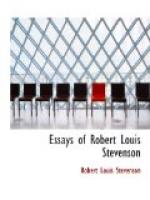[Note 19: Like a thorough “glutton." This is still the slang of the prize-ring. When a man is able to stand a great deal of punching without losing consciousness or courage, he is called a “glutton for punishment.”]
[Note 20: Athelred. Sir Walter Simpson, who was Stevenson’s companion on the Inland Voyage. For a good account of him, see Balfour’s Life of Stevenson, I, 106.]
[Note 21: “Dry light.” “The more perfect soul,” says Heraclitus, “is a dry light, which flies out of the body as lightning breaks from a cloud.” Plutarch, Life of Romulus.]
[Note 22: Opalstein. This was the writer and art critic, John Addington Symonds (1840-1893). Like Stevenson, he was afflicted with lung trouble, and spent much of his time at Davos, Switzerland, where a good part of his literary work was done. “The great feature of the place for Stevenson was the presence of John Addington Symonds, who, having come there three years before on his way to Egypt, had taken up his abode in Davos, and was now building himself a house. To him the newcomer bore a letter of introduction from Mr. Gosse. On November 5th (1880) Louis wrote to his mother: ’We got to Davos last evening; and I feel sure we shall like it greatly. I saw Symonds this morning, and already like him; it is such sport to have a literary man around.... Symonds is like a Tait to me; eternal interest in the same topics, eternal cross-causewaying of special knowledge. That makes hours to fly.’ And a little later he wrote: ’Beyond its splendid climate, Davos has but one advantage—the neighbourhood of J.A. Symonds. I dare say you know his work, but the man is far more interesting.’” (Balfour’s Life of Stevenson, I, 214.) When Symonds first read the essay Talk and Talkers, he pretended to be angry, and said, “Louis Stevenson, what do you mean by describing me as a moonlight serenader?” (Life, I, 233.)]
[Note 23: Proxime accessit. “He comes very near to it.”]
[Note 24: Sirens ... Sphinx Byronic ... Horatian ... Don Giovanni ... Beethoven. The Sirens were the famous women of Greek mythology, who lured mariners to destruction by the overpowering sweetness of their songs. How Ulysses outwitted them is well-known to all readers of the Odyssey. One of Tennyson’s earlier poems, The Sea-Fairies, deals with the same theme, and indeed it has appeared constantly in the literature of the world.... The Sphinx, a familiar subject in Egyptian art, had a lion’s body, the head of some other animal (sometimes man) and wings. It was a symbolical figure. The most famous example is of course the gigantic Sphinx near the Pyramids in Egypt, which has proved to be an inexhaustible theme for speculation and for poetry.... The theatrically tragic mood of Byron is contrasted with the easy-going, somewhat cynical epicureanism of Horace.... Don




